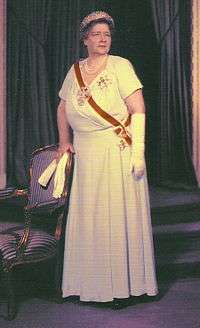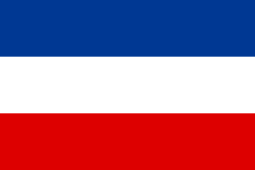Maria of Yugoslavia
| Maria, Queen consort of Yugoslavia | |
|---|---|
| Queen consort of Yugoslavia | |
 | |
| Queen consort of Yugoslavia Queen of the Kingdom of Serbs, Croats and Slovenes (1922-1929) | |
| Tenure | 8 June 1922 – 9 October 1934 |
| Born |
6 January 1900 Gotha, German Empire |
| Died |
22 June 1961 (aged 61) London, England |
| Burial |
Royal Burial Ground, Frogmore, Windsor (1961–2013) Royal Mausoleum Oplenac, Serbia (since 2013) |
| Spouse | Alexander I of Yugoslavia |
| Issue |
Peter II of Yugoslavia Prince Tomislav Prince Andrew |
| House | Hohenzollern-Sigmaringen |
| Father | Ferdinand I of Romania |
| Mother | Princess Marie of Edinburgh |
| Religion | Eastern Orthodox |
| Styles of Queen Maria of Yugoslavia | |
|---|---|
 | |
| Reference style | Her Majesty |
| Spoken style | Your Majesty |
| Alternative style | Ma'am |
Princess Maria of Romania (6 January 1900–22 June 1961), known in Serbian as Marija Karađorđević (Serbian Cyrillic: Марија Карађорђевић) was the Queen of Yugoslavia as the wife of King Alexander from 1922 until his assassination in 1934. She was the mother of Peter II of Yugoslavia, the last king of Yugoslavia. Her citizenship was revoked and her property confiscated by the Yugoslavian Communist regime in 1947, but she was "rehabilitated" in 2014.[1]
Early life
Maria was born in Gotha, a town in Thuringia, in the German Empire. She was known as Mignon in the family to distinguish her from her mother. Her parents were Marie of Edinburgh and Ferdinand of Romania. She had three brothers and two sisters: Carol, future King of Romania (Carol II); Nicholas, Prince of Romania; Elisabeta, Princess of Romania and future Queen of Greece; Ileana, Princess of Romania and future Archduchess of Austria (Tuscan line); and another brother, Mircea, who died at age three.
During World War I, she worked as a nurse with her mother.
Marriage and children
Maria married Alexander I of Yugoslavia, King of the Kingdom of Serbs, Croats and Slovenes in Belgrade on 8 June 1922, and had three sons:
- King Peter II (1923–70)
- Prince Tomislav (1928–2000)
- Prince Andrej (1929–90)
Following the assassination of King Alexander I of Yugoslavia in Marseille in 1934, her oldest son became Peter II of Yugoslavia, the last Yugoslav king. She was given the title Queen Mother of Yugoslavia in 1941. She moved to a farm in England and lived a relatively normal life without royal extravagance. Maria was well educated. She spoke several languages fluently and enjoyed painting and sculpting. She also drove a car by herself, which was very unusual for royalty at the time.[2]
She died in exile in London on 22 June 1961 and was interred at the Royal Burial Ground at Frogmore, which adjoins Windsor Castle before her remains were transferred to Serbia in April 2013 and re-interred on 26 May 2013 in Oplenac, Serbia.[3]
Humanitarian work

Queen Maria was popular and respected by the Serbian public, and is still well thought of in the region. She was regarded as an ideal wife and mother according to the contemporary Serbian ideal and described as a humble person. She was engaged in several social projects. In the eyes of the Serbian people, she remains one of the greateast patrons of charities in Serbia.
Streets are named in her memory, such as “Ulica kraljice Marije” or “Queen Maria Street”, and numerous schools and other organizations still carry her name.
Titles, styles, honours and arms
Titles and styles
- 6 January 1900 – 8 June 1922: Her Royal Highness Princess Maria of Romania, Princess of Hohenzollern-Sigmaringen
- 8 June 1922 – 6 January 1929: Her Majesty The Queen of Serbs, Croats and Slovenes
- 6 January 1929 – 9 October 1934: Her Majesty The Queen of Yugoslavia
- 9 October 1934 – 29 November 1945: Her Majesty Queen Maria of Yugoslavia, The Queen Mother
- 29 November 1945 – 22 June 1961 in pretense: Her Majesty Queen Maria of Yugoslavia
Honours
-
 Kingdom of Romania: Dame Grand Cross of the Order of Carol I[4]
Kingdom of Romania: Dame Grand Cross of the Order of Carol I[4] -
 Kingdom of Romania: Dame Grand Cross of the Order of the Crown of Romania[5]
Kingdom of Romania: Dame Grand Cross of the Order of the Crown of Romania[5] -
 Kingdom of Yugoslavia: Dame Grand Cross of the Order of the Star of Karađorđe (8 June 1922)[6][7]
Kingdom of Yugoslavia: Dame Grand Cross of the Order of the Star of Karađorđe (8 June 1922)[6][7] -
 Kingdom of Yugoslavia: Dame Grand Cross of the Order of the Yugoslav Crown
Kingdom of Yugoslavia: Dame Grand Cross of the Order of the Yugoslav Crown -
 France: Dame Grand Cross of the Legion of Honour (1959)[8]
France: Dame Grand Cross of the Legion of Honour (1959)[8]
Ancestry
Sources
- ↑ Crnjanski Spasojević, V. "Rehabilitovana kraljica Marija Karađorđević". Večernje novosti. Retrieved 2014-05-02.
- ↑ "Yugoslavia's exiled queen". Daily Telegraph.
- ↑ Yugoslavia's exiled Queen returns home at long last
- ↑ Order of the Star of Karađorđe
- ↑ Royal Family of Serbia
- ↑ Queen Maria
External links
| Maria of Yugoslavia Cadet branch of the House of Hohenzollern Born: 6 January 1900 Died: 22 June 1961 | ||
| Yugoslavian royalty | ||
|---|---|---|
| Vacant Title last held by Draga Obrenovićas Queen consort of Serbia |
Queen consort of Serbs, Croats, and Slovenes later of Yugoslavia 8 June 1922 – 9 October 1934 |
Vacant Title next held by Alexandra of Greece and Denmark |